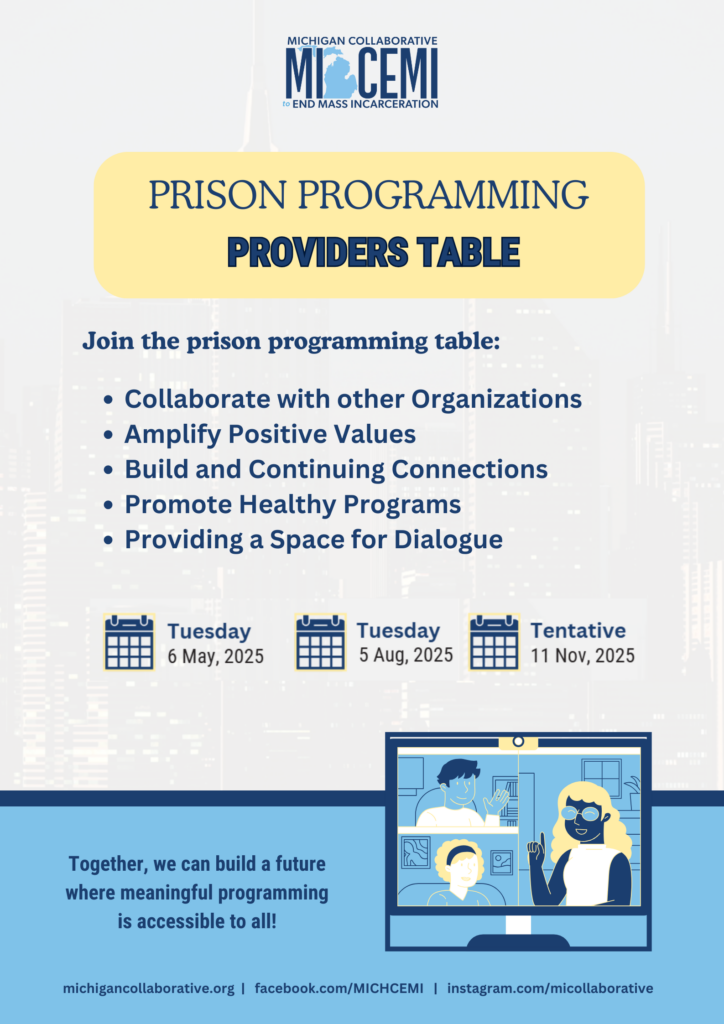Thank you to everyone who joined us for the first MI-CEMI Prison Programming Providers Table quarterly convening of 2025. Our discussion explored key strategies, challenges, and opportunities to strengthen programming in-reach and relationship-building efforts.
The discussion highlighted that, while there is an important role for department-provided and mandated programming, there is a special transformative power when people voluntarily choose to participate in programming offered by peers and community members.
Key Lessons For In reach and Relationship Building: Panelists shared the following tips to help you successfully get your volunteers into facilities, build appropriate relationships, and deliver quality programming.
- Building Relationships with Institutions, especially leadership: Establishing strong relationships with wardens can help address challenges at lower levels and improve communication channels. Some ways to help do that include:
- Streamline Administration Contacts: Having a single point of contact with prison administration can prevent overwhelm and ensure smooth coordination.
- Demonstrate Value to Administration: Showing the tangible benefits of programming (for example, calming tensions at the facility) can strengthen institutional buy-in.
- Screen your External Participants: Organizations should vet their volunteers and outside participants to maintain credibility and safety.
- Treat all with Dignity and Humanity: When people are treated with civility and humanity, it fosters a more positive and productive rehabilitation environment. This applies both to staff and program participants.
- Respect Personal Identity: Supporting incarcerated individuals without forcing them to relinquish their religious or cultural identity builds trust and engagement.
- Persist past obstruction: Recognize that some staff members may be resistant to change but still treating them with dignity fosters more effective collaboration.
- Maintain Appropriate Relationships: While effective programming requires solid relationships and some degree of familiarity, be sure to maintain appropriate boundaries. Actions that can seem innocuous may have greater significance than you are aware of and can negatively impact dynamics inside, program participants, or the program itself.
- Some programs have been able to appropriately maintain communication between visits by having an organizational, not personal, point of contact for messages (both JPay and phone). See also “Coordinating between sessions” under “Obstacles to Successful Programming,” below (not a personal) point of contact for messages.
- Promote a Unified Mission: Collaboration between various programming providers helps ensure incarcerated individuals receive comprehensive support.
- Continue Support Post-Release: Programming providers should extend support beyond prison walls, ensuring individuals have a network when they return to the community.
Obstacles to Successful Programming: Participants also raised several barriers that limit their ability to provide quality programs:
- Challenges with Staffing Changes: Frequent turnover and short-term contracts for wardens make it harder to maintain consistency in programming efforts.
- Navigating Bureaucratic Barriers: There is a need for clearer and more accessible processes for all partners involved in programming.
- Concerns Over Censorship: Reports of Nation of Islam books being banned highlight ongoing issues with access to educational and religious materials.
Coordinating Between Sessions: Some providers have developed methods by which participants can communicate with providers between sessions (e.g. incarcerated college students can Jpay a college contact who forwards their messages to the appropriate professors). Other programs have struggled to establish systems to coordinate between sessions (e.g. facility administration prevents volunteers with the National Lifers of America chapter at Women’s Huron Valley from coordinating program activities with the chapter leadership inside between sessions).
Join the Prison Programming Providers Table

Are you looking for a way to make a real impact in supporting incarcerated individuals and strengthening programming? Join the MI-CEMI Prison Programming Table, a collaborative space where organizations and advocates come together to build meaningful, sustainable change.
Why Join?
Our collective efforts help:
- Collaboration with Other Organizations: To work together with various organizations that offer programming inside prisons.
- Amplifying Positive Values: To promote hope, education, humanity, faith, and creativity for incarcerated individuals.
- Building and Continuing Connections: To create and sustain connections with organizations across the state of Michigan.
- Promoting Healthy Programs: To develop a vision that supports and promotes healthy programs within Michigan prisons.
- Providing a Space for Dialogue: To offer a platform for discussing how to improve prison programming and address deficiencies and inconsistencies in current programs.
Catch Us Next Time!
We’ll be back with more discussions and opportunities to collaborate. Mark your calendar for our upcoming sessions:
- May 6 (12-2 PM, Virtual)
- August 5 (12-2 PM, Virtual)
- November 11 (Tentative, potential in-person session with incarcerated partners)

How to Get Involved
Reach out to us to learn more about joining the Prison Programming Providers Table. The table focuses on supporting organizations who offer educational, religious, arts, or other types of programming to people incarcerated at the Michigan Department of Corrections. Membership is open to all providers, advocates, and returning citizens.
Sign up today and be part of the solution!
Visit our events page or follow us on Facebook and Instagram to stay updated on our events.
Together, we can build a future where meaningful programming is accessible to all!
